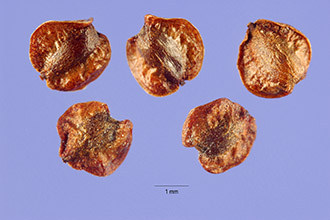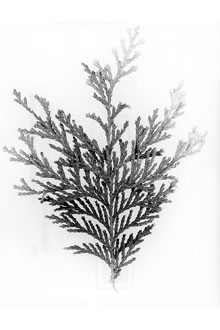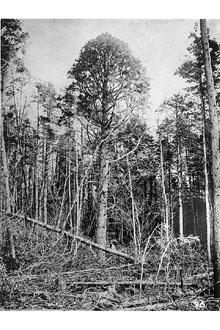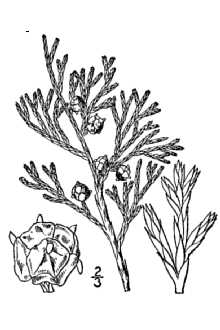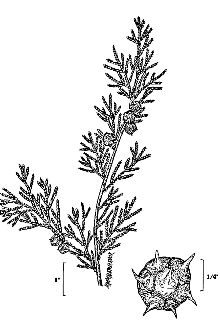Atlantic White Cedar
Scientific Name: Chamaecyparis thyoides (L.) Britton, Sterns & Poggenb.
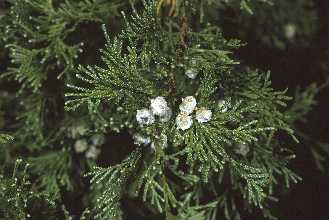
| General Information | |
|---|---|
| Usda Symbol | CHTH2 |
| Group | Gymnosperm |
| Life Cycle | Perennial |
| Growth Habits | Tree |
| Native Locations | CHTH2 |
Plant Guide
Uses
The wood is light, soft, close-grained, and slightly fragrant. It is easily worked, resistant to decay, and shrinks and warps very little during seasoning. It has been used for shingles, posts, woodenware, and interior finishes, but primary current uses are for telephone poles, piling, ties, siding, and boat railing. Many cultivars of Atlantic white-cedar have been described (see Rehder 1949). Heavy cutting for many commercial uses during this century has considerably reduced even the largest stands, but it is still considered a commercially important species in the major supply areas of southeastern Virginia, North Carolina, South Carolina, and northwestern Florida. Cultivars have been selected for shape and needle color – they are useful for naturalizing in wet areas.
Status
Please consult the PLANTS Web site and your State Department of Natural Resources for this plant’s current status, such as, state noxious status and wetland indicator values. Atlantic white-cedar is considered rare in Georgia, Mississippi, Maine, Maryland, New York, New Hampshire, and Maine. Robert H. Mohlenbrock USDA, NRCS, Wetland Science Institute @ PLANTS
Description
General: Cypress family (Cupressaceae). Native evergreen trees growing to 20 (-28) meters tall; trunks to 0.8 (-1.5) meters in diameter. Bark: reddish-brown, irregularly furrowed and ridged, peeling in long, fibrous strips, often partially twisted around the trunk. Branchlets are terete or rhombic in cross-section, in fan-shaped sprays, covered with dark blue-green, overlapping scale leaves to 2 mm long; facial and lateral leaves similar, usually with circular leaf glands. Seed cones are globose, 4-9 mm broad, bluish-purple to reddish-brown at maturity, with a somewhat crumpled appearance; scales 5-7. Native. The common name reflects its occurrence on the Atlantic coastal plain and its light-colored wood. Variation within the species: populations of Atlantic white-cedar in Florida, Alabama, and Mississippi have been segregated as Chamaecyparis henryae Li (= C. thyoides var. henryae (Li) Little), based on differences in bark, branchlets, leaves, and fruit, but the species also is variable in the Atlantic coastal segment of its range and the Gulf coast segregate has not generally been accepted. Arborvitae (Thuja occidentalis) can be distinguished from Atlantic white-cedar by its flattened branchlets with clearly differentiated facial and lateral leaves and its ellipsoid seed cones. Distribution: Atlantic white-cedar grows in a narrow coastal belt 80 to 210 km (50 to 130 miles) wide from southern Maine to northern Florida and west to southern Mississippi. The scarcity of suitable growing sites makes distribution of the species within the coastal belt very patchy. The species is now classified as rare in Georgia, Mississippi, Maine, Maryland, New York, New Hampshire, and Maine.
Adaptation
Atlantic white-cedar is found most frequently in small dense stands in fresh water swamps and bogs, sometimes on sandy soils, but usually on acidic muck (peat). The species is absent or uncommon in areas where muck is underlain by clay or contains appreciable amounts of silt or clay. Habitats in southeastern New Jersey range from about 1 meter elevation, where the trees border the tidal marsh, to 43 meters in some inland stands. The species currently grows in at least one upland bog in northern New Jersey at an elevation of 457 meters.
Establishment
Trees of Atlantic white-cedar in open stands start bearing seed at 4-5 years, although these seeds may be relatively low in viability; trees in dense stands begin cone production at 10-20 years. Fair to excellent seed crops are produced each year. Germination occurs in a variety of light conditions, even in very low light intensity, but relatively open conditions are essential for good survival and growth of Atlantic white-cedar seedlings in competition with associates of shrubs and hardwoods (especially red maple, blackgum, sweetbay, and others). Establishment in nature usually occurs following disturbance of the canopy. Seedlings develop a very short taproot, and successful establishment requires not only adequate surface moisture for seed germination but also available moisture within reach of the shallow root systems. Suitable seedbeds include moist rotting wood, Sphagnum moss, muck, and moist mineral soil – these on hummocks where standing water is not present all year. Thick litter and slash are unfavorable for germination and establishment. Increases in height slow after about 50 years and stop after 100 years; increases in diameter may continue at a relatively even rate up to 100 years. Stand age rarely exceeds 200 years, although some trees have apparently have reached 1000 years of age.
Management
Because of the shallow root system, trees of Atlantic white-cedar are extremely susceptible to windthrow, especially where they occur in permanently saturated sites and where stands have been opened by partial cuttings. Fungi and insects usually do not cause serious damage. Cultivars, Improved and Selected Materials (and area of origin) Contact your local Natural Resources
Conservation
Service (formerly Soil Conservation Service) office for more information. Look in the phone book under ”United States Government.” The Natural Resources Conservation Service will be listed under the subheading “Department of Agriculture.”
References
Li, H,L, 1962, A new species of Chamaecyparis, Morris Arboret, Bull, 13:43-46, Little, S, & P,W, Garrett 1990, Chamaecyparis thyoides, Pp, 103-108, in R,M, Burns and B,H, Honkala, Silvics of North America, Volume 1, Conifers, USDA Forest Service Agric, Use soil moisture sensors to measure the soil moisture of Atlantic White Cedar., Handbook 654, Washington, D,C, <http://willow,ncfes,umn,edu/silvics_manual/Table_of_contents,htm> Michener, D,C, 1993, Chamaecyparis, Pp, 408-410, in Flora of North America, north of Mexico, Vol, 2, Pteridophytes and Gymnosperms, Oxford Univ, Press, New York, New York, <http://hua,huh,harvard,edu/cgi-bin/Flora/flora,pl?FLORA_ID=12395> Rehder, A,J, 1949, Bibliography of cultivated trees and shrubs hardy in the cooler temperate regions of the Northern Hemisphere, Jamaica Plain,
Fact Sheet
Uses
Buffers: Atlantic white cedar is not often used due to its exacting site requirements, but has potential for use on coastal buffer sites, in wetlands, and for re-creating cedar swamps. Wildlife: This species is a highly preferred food of deer during winter stress periods. It can easily be browsed out as seedlings or saplings with extensive damage done.
Status
Please consult the PLANTS Web site and your State Department of Natural Resources for this plant’s current status (e,g, threatened or endangered species, state noxious status, and wetland indicator values), Use soil moisture sensors to measure the soil moisture of Atlantic White Cedar.,
Description
Atlantic white cedar is one of only six species in this genus. Only three of the six are native to the continent, and two of them are west coast species. This leaves Atlantic white cedar as the only representative in the East, where it occurs in a narrow band along the Atlantic coast. Atlantic white cedar is an evergreen with scaly leaves that occur in a flat fern-like appearance. This species usually grows in very dense, solid stands, and has small rounded cones. However, Atlantic white cedar can be confused with arborvitae (also called northern white cedar -Thuja occidentalis) which also occurs in the region where the ranges overlap in New York and New England. In Atlantic white cedar, the evergreen leaves are paired and have short points on the tip. Arborvitae has leaves that are more rounded-appearing to the naked eye but also have short points when viewed closely or with a lens. Arborvitae has cones of similar size but are more elongated than those of Atlantic white cedar. Robert H. Mohlenbrock USDA NRCS 1995. Northeastern Wetland Flora @ USDA NRCS PLANTS
Adaptation and Distribution
Distribution
Distribution
Atlantic white cedar is adapted to acid (pH 5.5 or lower), wet, lowland sites within 200 feet elevation of seas level. The growing season is about 140 days or longer. The habitat of this species is very limited, and increasingly rare due to coastal development. Associated trees include red maple, black gum, white pine, hemlock, gray birch, and pitch pine. Associated shrubs include lowbush and highbush blueberry. The great range in latitude that white cedar occupies (from Maine to Florida) helps account for the broad species association. Arborvitae has a much broader longitudinal and elevational range, and is adapted to soils that are slightly acid to alkaline. Arborvitae grows on upland and lowland sites, and in areas with growing seasons as short as 30 days up to 200 days. Both species can be grown on wet, lowland sites with moderate acidity. For a current distribution map, please consult the Plant Profile page for this species on the PLANTS Website.
Establishment
Due to the dense stands which white cedar often creates, it should not be surprising that 8-9 million seeds per acre may be disbursed in a decent seed crop. These seeds are winged and very light, and may be carried long distances by strong winds. Seed dormancy is common and seed can remain viable in the forest litter for many years. Light and moisture are required for germination to occur, and continuous moisture appears to be mandatory. Seedlings grow to saplings at the rate of about 12 inches per year on favorable sites with open but moist conditions. Seedlings are very vulnerable to crowding from other species. White cedar seedlings are not commonly grown in the nursery, so little is documented about the size and age of transplants. It is likely that the 1-0 class would be preferred as bare-root stock. White cedar has a shallow root system, so suitable planting sites must have abundant moisture very close to the surface.
Management
Site selection is critical to the success of white cedar. Moisture must be reliable, and competition from other species must be controlled. The site must also have protection from high winds or else severe wind-throw will result. Fire will readily kill white cedar if it gets into the crowns. Finally, heavy ice and snow will often break or topple young trees. Deer will preferentially browse white cedar. Beaver presence favors white cedar as deciduous species are preferentially cut by them, leaving the cedar saplings or poles.
Plant Traits
Growth Requirements
| Temperature, Minimum (°F) | -36 |
|---|---|
| Adapted to Coarse Textured Soils | Yes |
| Adapted to Fine Textured Soils | No |
| Adapted to Medium Textured Soils | Yes |
| Anaerobic Tolerance | High |
| CaCO3 Tolerance | None |
| Cold Stratification Required | Yes |
| Drought Tolerance | None |
| Fertility Requirement | Medium |
| Fire Tolerance | Medium |
| Frost Free Days, Minimum | 140 |
| Hedge Tolerance | Medium |
| Moisture Use | Low |
| pH, Maximum | 6.3 |
| pH, Minimum | 3.5 |
| Planting Density per Acre, Maxim | 1700 |
| Planting Density per Acre, Minim | 300 |
| Precipitation, Maximum | 70 |
| Precipitation, Minimum | 40 |
| Root Depth, Minimum (inches) | 16 |
| Salinity Tolerance | None |
| Shade Tolerance | Intermediate |
Morphology/Physiology
| Bloat | None |
|---|---|
| Toxicity | None |
| Resprout Ability | No |
| Shape and Orientation | Erect |
| Active Growth Period | Spring and Summer |
| C:N Ratio | High |
| Coppice Potential | No |
| Fall Conspicuous | No |
| Fire Resistant | No |
| Flower Color | Green |
| Flower Conspicuous | No |
| Foliage Color | Green |
| Foliage Porosity Summer | Dense |
| Foliage Porosity Winter | Dense |
| Foliage Texture | Medium |
| Fruit/Seed Conspicuous | No |
| Nitrogen Fixation | None |
| Low Growing Grass | No |
| Lifespan | Long |
| Leaf Retention | Yes |
| Known Allelopath | No |
| Height, Mature (feet) | 50.0 |
| Height at 20 Years, Maximum (fee | 20 |
| Growth Rate | Moderate |
| Growth Form | Single Stem |
| Fruit/Seed Color | Brown |
Reproduction
| Vegetative Spread Rate | Moderate |
|---|---|
| Small Grain | No |
| Seedling Vigor | Medium |
| Seed Spread Rate | Moderate |
| Fruit/Seed Persistence | Yes |
| Seed per Pound | 460000 |
| Propagated by Tubers | No |
| Propagated by Sprigs | No |
| Propagated by Sod | No |
| Propagated by Seed | Yes |
| Propagated by Corm | No |
| Propagated by Container | Yes |
| Propagated by Bulb | No |
| Propagated by Bare Root | Yes |
| Fruit/Seed Period End | Fall |
| Fruit/Seed Period Begin | Fall |
| Commercial Availability | Routinely Available |
| Bloom Period | Spring |
| Propagated by Cuttings | No |
Suitability/Use
| Veneer Product | No |
|---|---|
| Pulpwood Product | No |
| Post Product | Yes |
| Palatable Human | No |
| Palatable Graze Animal | Low |
| Palatable Browse Animal | High |
| Nursery Stock Product | Yes |
| Naval Store Product | No |
| Lumber Product | Yes |
| Fuelwood Product | Low |
| Fodder Product | No |
| Christmas Tree Product | No |
| Berry/Nut/Seed Product | No |

